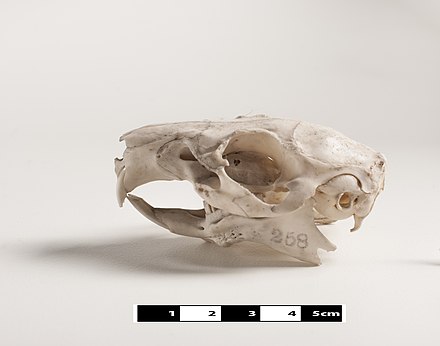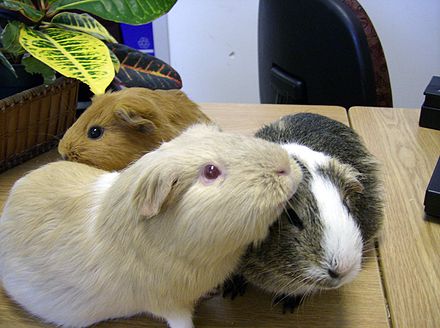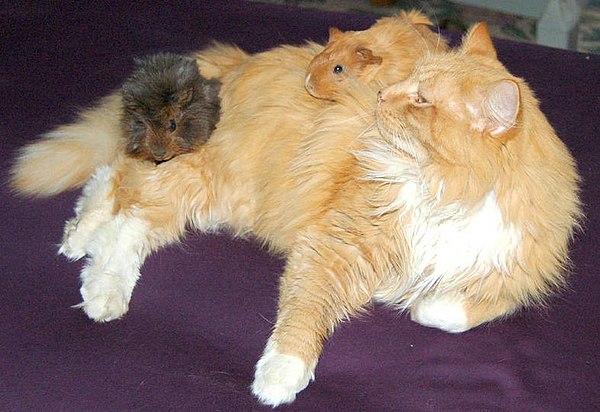
History
Cavia porcellus is not found naturally in the wild; it is likely descended from closely related species of cavies, such as C. aperea, C. fulgida, and C. tschudii, which are still commonly found in various regions of South America.[2] Studies from 2007 to 2010 applied molecular markers,[6][7] and studied the skull and skeletal morphology of current and mummified animals,[8] thereby revealing the ancestor to most likely be C. tschudii. Some species of cavy identified in the 20th century, such as C. anolaimae and C. guianae, may be domestic guinea pigs that have become feral by reintroduction into the wild.[9] Wild cavies are found on grassy plains and occupy an ecological niche similar to that of cattle. They are social animals, living in the wild in small groups ("herds") that consist of several females ("sows"), a male ("boar"), and their young ("pups" not "piglets", a break with the preceding porcine nomenclature). Herds of animals move together, eating grass or other vegetation, yet do not store food.[10] While they do not burrow themselves or build nests, they frequently seek shelter in the burrows of other animals, as well as in crevices and tunnels formed by vegetation.[10] They are crepuscular and tend to be most active during dawn and dusk, when it is harder for predators to spot them.[11] Regionally known as cuy, the guinea pig was first domesticated as early as 5000 BC for food by tribes in the Andean region of South America (the present-day southern part of Colombia, Ecuador, Peru, and Bolivia),[12] some thousands of years after the domestication of the South American camelids.[13] Statues dating from circa 500 BC to 500 AD that depict guinea pigs have been unearthed in archaeological digs in Peru and Ecuador.[14] The Moche people of ancient Peru worshipped animals and often depicted the guinea pig in their art.[15] From about 1200 to the Spanish conquest in 1532, the indigenous peoples used selective breeding to develop many varieties of domestic guinea pigs, which formed the basis for some of the modern domestic breeds.[9] They continue to be a food source in the region; many households in the Andean highlands raise the animal, which subsists on the family's vegetable scraps.[16] Folklore traditions involving guinea pigs are numerous; they are exchanged as gifts, used in customary social and religious ceremonies, and frequently referred to in spoken metaphors.[17] They also are used in traditional healing rituals by folk doctors, or curanderos, who use the animals to diagnose diseases such as jaundice, rheumatism, arthritis, and typhus.[18] They are rubbed against the bodies of the sick, and are seen as a supernatural medium.[19] Black guinea pigs are considered especially useful for diagnoses.[20] The animal may be cut open and its entrails examined to determine whether the cure was effective.[21] These methods are widely accepted in many parts of the Andes, where Western medicine is either unavailable or distrusted.[22] Spanish, Dutch, and English traders took guinea pigs to Europe, where they quickly became popular as exotic pets among the upper classes and royalty, including Queen Elizabeth I.[12] The earliest known written account of the guinea pig dates from 1547, in a description of the animal from Santo Domingo. Because cavies are not native to Hispaniola, the animal was believed to have been earlier introduced there by Spanish travelers.[2] However, based on more recent excavations on West Indian islands, the animal must have been introduced to the Caribbean around 500 BC by ceramic-making horticulturalists from South America.[23] It was present in the Ostionoid period on Puerto Rico, for example, long before the advent of the Spaniards.[24] The guinea pig was first described in the West in 1554 by the Swiss naturalist Conrad Gessner.[25] Its binomial scientific name was first used by Erxleben in 1777; it is an amalgam of Pallas' generic designation (1766) and Linnaeus' specific conferral (1758).[2] The earliest-known European illustration of a domestic guinea pig is a painting (artist unknown) in the collection of the National Portrait Gallery in London, dated to 1580, which shows a girl in typical Elizabethan dress holding a tortoise-shell guinea pig in her hands. She is flanked by her two brothers, one of whom holds a pet bird.[26] The picture dates from the same period as the oldest recorded guinea pig remains in England, which are a partial cavy skeleton found at Hill Hall, an Elizabethan manor house in Essex, and dated to around 1575.[26]Characteristics
Main article: List of guinea pig breeds Parti-colored Abyssinian guinea pigs Guinea pigs are large for rodents; the common pet breeds weigh between 700 and 1,200 g (1.5 and 2.6 lb) when fully grown and measure between 20 and 25 cm (8 and 10 in) in length.[27] Some livestock breeds weigh 3 kilograms (6.6 lb) when full grown.[28] Pet breeds live an average of four to five years, but may live as long as eight years.[29] According to Guinness World Records, as of 2006, the longest-lived guinea pig was 14 years, 10 months, and 2 weeks old.[30] Most guinea pigs have fur, but one laboratory breed adopted by some pet owners, the skinny pig, is a mostly furless breed. Some breeds are long-fur breeds such as the Peruvian, the Silkie, and the Texel. In the 1990s, a minority scientific opinion emerged proposing that caviomorphs such as guinea pigs, chinchillas, and degus are not actually rodents, and should be reclassified as a separate order of mammals (similar to the rodent-like lagomorphs which includes rabbits).[31][32][33] Subsequent research using wider sampling restored the consensus among mammalian biologists regarding the current classification of rodents, including guinea pigs, as monophyletic.[34][35] Male and female guinea pigs do not differ in appearance apart from general size. The position of the anus is very close to the genitals in both sexes. Sexing animals at a young age must be done by someone who has been trained in the differences. Female genitals are distinguished by a "Y"-shaped configuration formed from a vulvar flap. While male genitals may look similar, with the penis and anus forming a similar shape, the penis will protrude if pressure is applied to the surrounding hair anterior to the genital region.[36] The male's testes may also be visible externally from scrotal swelling. File:Guinea pigs - Japanese petting zoo - 2018 6 26.webm Guinea pigs in a petting zoo.
Behavior
Guinea pigs "social groom" each other Guinea pigs can learn complex paths to food, and can accurately remember a learned path for months. Their strongest problem-solving strategy is motion.[37] While guinea pigs can jump small obstacles, they cannot jump very high. Most of them are poor climbers, and are not particularly agile. They startle easily, and when they sense danger either freeze in place for long periods, or run for cover with rapid, darting motions.[11] Larger groups of startled guinea pigs "stampede", running in haphazard directions as a means of confusing predators.[38] When happily excited, guinea pigs may (often repeatedly) perform little hops in the air (a movement known as "popcorning"), analogous to the ferret's war dance,[39] and also similar to rabbit happy hops. Guinea pigs are also good swimmers,[40] although they do not like being wet and infrequently need bathing. Like many rodents, guinea pigs sometimes participate in social grooming, and they regularly self-groom.[41] A milky-white substance is secreted from their eyes and rubbed into the hair during the grooming process.[42] Groups of boars often chew each other's hair, but this is a method of establishing hierarchy within a group, rather than a social gesture.[40] Dominance is also established through biting (especially of the ears), piloerection, aggressive noises, head thrusts, and leaping attacks.[43] Non-sexual simulated mounting for dominance is also common among same-sex groups.[citation needed] Guinea pig eyesight is not as good as that of a human in terms of distance and color, but they have a wider angle of vision (about 340°) and see in partial color (dichromacy). They have well-developed senses of hearing, smell, and touch.[44][45] Guinea pigs have developed a different biological rhythm from their wild counterparts, and have longer periods of activity followed by short periods of sleep in between.[11] Activity is scattered randomly throughout the day; aside from an avoidance of intense light, no regular circadian patterns are apparent.[11] Although this cat has accepted these guinea pigs, the success of interspecies interaction depends on the individual animals. Guinea pigs do not generally thrive when housed with other species. Larger animals may regard guinea pigs as prey, though some dogs and cats can be trained to accept them.[46] Opinion is divided over the cohousing of guinea pigs and rabbits. Some published sources say that guinea pigs and rabbits complement each other well when sharing a cage.[46][47] However, rabbits have different nutritional requirements; as lagomorphs, they synthesize their own Vitamin C, so the two species will not thrive if fed the same food when housed together.[48] Rabbits may also harbor diseases (such as respiratory infections from Bordetella and Pasteurella), to which guinea pigs are susceptible.[49] Housing guinea pigs with other rodents such as gerbils and hamsters may increase instances of respiratory and other infections,[50] and such rodents may act aggressively toward guinea pigs.[51]
Vocalization
Vocalization is the primary means of communication between members of the species.[52] These are the most common sounds made by the guinea pig:[53] A "wheek" is a loud noise, the name of which is onomatopoeic, also known as a whistle. An expression of general excitement, it may occur in response to the presence of its owner or to feeding. It is sometimes used to find other guinea pigs if they are running. If a guinea pig is lost, it may wheek for assistance. audio speaker iconlisten (help·info) A bubbling or purring sound is made when the guinea pig is enjoying itself, such as when being petted or held. It may also make this sound when grooming, crawling around to investigate a new place, or when given food. audio speaker iconlisten (help·info) A rumbling sound is normally related to dominance within a group, though it can also come as a response to being scared or angry. In the case of being scared, the rumble often sounds higher and the body vibrates shortly. While courting, a male usually purrs deeply, swaying and circling the female[54] in a behavior called rumblestrutting. A low rumble while walking away reluctantly shows passive resistance. audio speaker iconlisten (help·info) Chutting and whining are sounds made in pursuit situations, by the pursuer and pursuee, respectively. audio speaker iconlisten (help·info) A chattering sound is made by rapidly gnashing the teeth, and is generally a sign of warning. Guinea pigs tend to raise their heads when making this sound. Squealing or shrieking is a high-pitched sound of discontent, in response to pain or danger. audio speaker iconlisten (help·info) Chirping, a less common sound, likened to bird song, seems to be related to stress or discomfort, or when a baby guinea pig wants to be fed. Very rarely, the chirping will last for several minutes. audio speaker iconlisten (help·info)
Living environment
Domestic guinea pigs generally live in cages, although some owners of large numbers of cavies dedicate entire rooms to their pets.[citation needed] Wire mesh floors can cause injury and may be associated with an infection commonly known as bumblefoot (ulcerative pododermatitis),[55] so cages with solid bottoms, where the animal walks directly on the bedding, are typically used. Large cages, which allow for adequate running space, can be constructed from wire grid panels and plastic sheeting, a style known as C&C, or "cubes and coroplast".[56] Red cedar (Eastern or Western) and pine, both softwoods, were commonly used as bedding, but now these materials are believed to contain harmful phenols (aromatic hydrocarbons) and oils.[57] Bedding materials made from hardwoods (such as aspen), paper products, and corn cobs are alternatives.[57] Guinea pigs tend to be messy; they often jump into their food bowls or kick bedding and feces into them, and their urine sometimes crystallizes on cage surfaces, making it difficult to remove.[58] After its cage has been cleaned, a guinea pig typically urinates and drags its lower body across the floor of the cage to mark its territory.[59] Male guinea pigs may mark their territory in this way when they are put back into their cages after being taken out.[citation needed] Guinea pigs thrive in groups of two or more; groups of sows, or groups of one or more sows and a neutered boar are common combinations, but boars can sometimes live together. Guinea pigs learn to recognize and bond with other individual pigs, and tests show that a boar's neuroendocrine stress response to a strange environment is significantly lowered in the presence of a bonded female, but not with unfamiliar females.[60] Groups of boars may also get along, provided their cage has enough space, they are introduced at an early age, and no females are present.[61] In Switzerland, where keeping a guinea pig without a companion is illegal, a service to rent guinea pigs (to temporarily replace a dead cage-mate) is available.[62] Sweden has similar laws against keeping a guinea pig by itself.[63]